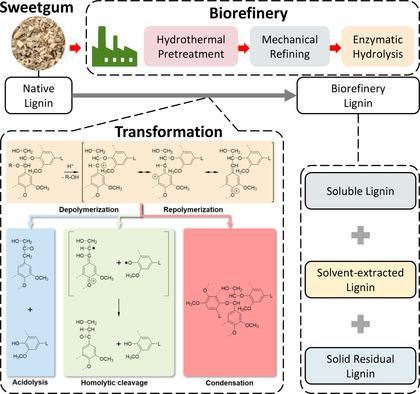当前位置:
X-MOL 学术
›
ChemSusChem
›
论文详情
Our official English website, www.x-mol.net, welcomes your
feedback! (Note: you will need to create a separate account there.)
Tracing Sweetgum Lignin's Molecular Properties through Biorefinery Processing.
ChemSusChem ( IF 7.5 ) Pub Date : 2020-05-25 , DOI: 10.1002/cssc.202001125 Xiao Jiang 1 , Robert H Narron 1 , Qiang Han 1 , Sunkyu Park 1 , Hou-Min Chang 1 , Hasan Jameel 1
ChemSusChem ( IF 7.5 ) Pub Date : 2020-05-25 , DOI: 10.1002/cssc.202001125 Xiao Jiang 1 , Robert H Narron 1 , Qiang Han 1 , Sunkyu Park 1 , Hou-Min Chang 1 , Hasan Jameel 1
Affiliation

|
Changes to the molecular properties of lignin over the course of biorefinery processing were investigated by using sweetgum as a feedstock. Hydrothermal pretreatment has been used because it is an economically attractive, green process. Three representative biorefinery lignin preparations were obtained, with about 70 % yield based on raw lignin. The three fractions included soluble lignin adsorbed on resin (XADL), solvent‐extracted lignin (HTCELp), and an additional ball‐milled residual lignin (HTRELp). By comparing the raw and biorefinery lignin preparations, it can be concluded that lignin undergoes both degradation and condensation throughout the various stages of the hydrothermal‐based biorefinery process. The two fractions made soluble by biorefinery processing, XADL and HTCELp, were found to be low‐molecular‐weight degradation products enriched with free phenolic hydroxyl groups. In addition, about 15 % of noncondensed phenolic units were involved in condensation reactions. Quantitative NMR spectroscopy analysis revealed that at least about 28 % of β‐O‐4′ substructures were cleaved. Hibbert's ketones were identified in XADL and HTRELp, which provided evidence of lignin undergoing acidolysis. The contents of β‐5′ and β‐β′ did not change significantly upon biorefinery processing. Finally, episyringaresinol was detected in XADL and HTCELp. It is hoped that these findings will help to further demonstrate the specific effects of biorefinery processing on lignin in hardwood and facilitate its utilization to improve biorefinery economics.
中文翻译:

通过生物精炼工艺追踪甜木素的分子性质。
以甘蔗为原料,研究了生物精炼过程中木质素分子性质的变化。使用水热预处理是因为它是一种经济上有吸引力的绿色工艺。获得了三种代表性的生物精制木质素制剂,基于原始木质素的收率约为70%。这三个部分包括吸附在树脂上的可溶性木质素(XADL),溶剂萃取的木质素(HTCELp)和另外的球磨残留木质素(HTRELp)。通过比较原始和生物精炼厂木质素制剂,可以得出结论,木质素在基于水热的生物精炼过程的各个阶段均经历降解和冷凝过程。XADL和HTCELp是通过生物精炼工艺可溶解的两个馏分,被发现是富含游离酚羟基的低分子量降解产物。另外,约15%的未缩合酚单元参与缩合反应。NMR定量分析表明,至少有28%的β-O-4'亚结构被裂解。在XADL和HTRELp中鉴定出了希伯特的酮,这为木质素进行酸解提供了证据。在生物精炼过程中,β-5'和β-β'的含量没有明显变化。最后,在XADL和HTCELp中检测到了丁香香脂素。希望这些发现将有助于进一步证明生物炼制工艺对硬木中木质素的特殊作用,并有助于其利用以改善生物炼制的经济性。约15%的未缩合酚单元参与缩合反应。NMR定量分析表明,至少有28%的β-O-4'亚结构被裂解。在XADL和HTRELp中鉴定出了希伯特的酮,这为木质素进行酸解提供了证据。在生物精炼过程中,β-5'和β-β'的含量没有明显变化。最终,在XADL和HTCELp中检测到了丁香香脂素。希望这些发现将有助于进一步证明生物炼制工艺对硬木中木质素的特殊作用,并有助于其利用以改善生物炼制的经济性。约15%的未缩合酚单元参与缩合反应。NMR定量分析表明,至少有28%的β-O-4'亚结构被裂解。在XADL和HTRELp中鉴定出了希伯特的酮,这为木质素进行酸解提供了证据。在生物精炼过程中,β-5'和β-β'的含量没有明显变化。最终,在XADL和HTCELp中检测到了丁香香脂素。希望这些发现将有助于进一步证明生物炼制工艺对硬木中木质素的特殊作用,并有助于其利用以改善生物炼制的经济性。在XADL和HTRELp中鉴定出了s酮,这为木质素进行酸解提供了证据。在生物精炼过程中,β-5'和β-β'的含量没有明显变化。最终,在XADL和HTCELp中检测到了丁香香脂素。希望这些发现将有助于进一步证明生物炼制工艺对硬木中木质素的特殊作用,并有助于其利用以改善生物炼制的经济性。在XADL和HTRELp中鉴定出了s酮,这为木质素进行酸解提供了证据。在生物精炼过程中,β-5'和β-β'的含量没有明显变化。最终,在XADL和HTCELp中检测到了丁香香脂素。希望这些发现将有助于进一步证明生物精炼工艺对硬木中木质素的特殊作用,并有助于其用于改善生物精炼经济学。
更新日期:2020-05-25
中文翻译:

通过生物精炼工艺追踪甜木素的分子性质。
以甘蔗为原料,研究了生物精炼过程中木质素分子性质的变化。使用水热预处理是因为它是一种经济上有吸引力的绿色工艺。获得了三种代表性的生物精制木质素制剂,基于原始木质素的收率约为70%。这三个部分包括吸附在树脂上的可溶性木质素(XADL),溶剂萃取的木质素(HTCELp)和另外的球磨残留木质素(HTRELp)。通过比较原始和生物精炼厂木质素制剂,可以得出结论,木质素在基于水热的生物精炼过程的各个阶段均经历降解和冷凝过程。XADL和HTCELp是通过生物精炼工艺可溶解的两个馏分,被发现是富含游离酚羟基的低分子量降解产物。另外,约15%的未缩合酚单元参与缩合反应。NMR定量分析表明,至少有28%的β-O-4'亚结构被裂解。在XADL和HTRELp中鉴定出了希伯特的酮,这为木质素进行酸解提供了证据。在生物精炼过程中,β-5'和β-β'的含量没有明显变化。最后,在XADL和HTCELp中检测到了丁香香脂素。希望这些发现将有助于进一步证明生物炼制工艺对硬木中木质素的特殊作用,并有助于其利用以改善生物炼制的经济性。约15%的未缩合酚单元参与缩合反应。NMR定量分析表明,至少有28%的β-O-4'亚结构被裂解。在XADL和HTRELp中鉴定出了希伯特的酮,这为木质素进行酸解提供了证据。在生物精炼过程中,β-5'和β-β'的含量没有明显变化。最终,在XADL和HTCELp中检测到了丁香香脂素。希望这些发现将有助于进一步证明生物炼制工艺对硬木中木质素的特殊作用,并有助于其利用以改善生物炼制的经济性。约15%的未缩合酚单元参与缩合反应。NMR定量分析表明,至少有28%的β-O-4'亚结构被裂解。在XADL和HTRELp中鉴定出了希伯特的酮,这为木质素进行酸解提供了证据。在生物精炼过程中,β-5'和β-β'的含量没有明显变化。最终,在XADL和HTCELp中检测到了丁香香脂素。希望这些发现将有助于进一步证明生物炼制工艺对硬木中木质素的特殊作用,并有助于其利用以改善生物炼制的经济性。在XADL和HTRELp中鉴定出了s酮,这为木质素进行酸解提供了证据。在生物精炼过程中,β-5'和β-β'的含量没有明显变化。最终,在XADL和HTCELp中检测到了丁香香脂素。希望这些发现将有助于进一步证明生物炼制工艺对硬木中木质素的特殊作用,并有助于其利用以改善生物炼制的经济性。在XADL和HTRELp中鉴定出了s酮,这为木质素进行酸解提供了证据。在生物精炼过程中,β-5'和β-β'的含量没有明显变化。最终,在XADL和HTCELp中检测到了丁香香脂素。希望这些发现将有助于进一步证明生物精炼工艺对硬木中木质素的特殊作用,并有助于其用于改善生物精炼经济学。











































 京公网安备 11010802027423号
京公网安备 11010802027423号